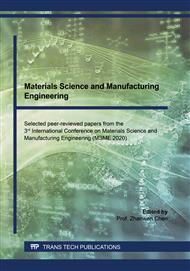[1]
Thomas D. Costs, benefits, and adoption of additive manufacturing: a supply chain perspective. The International Journal of Advanced Manufacturing Technology. 2016;85(5): 1857-76.
DOI: 10.1007/s00170-015-7973-6
Google Scholar
[2]
Attaran M. The rise of 3-D printing: The advantages of additive manufacturing over traditional manufacturing. Business Horizons. 2017;60(5):677-88.
DOI: 10.1016/j.bushor.2017.05.011
Google Scholar
[3]
Najmon JC, Raeisi S, Tovar A. 2 - Review of additive manufacturing technologies and applications in the aerospace industry. In: Froes F, Boyer R, editors. Additive Manufacturing for the Aerospace Industry: Elsevier; 2019. pp.7-31.
DOI: 10.1016/b978-0-12-814062-8.00002-9
Google Scholar
[4]
Liu R, Wang Z, Sparks T, Liou F, Newkirk J. 13 - Aerospace applications of laser additive manufacturing. In: Brandt M, editor. Laser Additive Manufacturing: Woodhead Publishing; 2017. pp.351-71.
DOI: 10.1016/b978-0-08-100433-3.00013-0
Google Scholar
[5]
Culmone C, Smit G, Breedveld P. Additive manufacturing of medical instruments: A state-of-the-art review. Additive Manufacturing. 2019; 27:461-73.
DOI: 10.1016/j.addma.2019.03.015
Google Scholar
[6]
Bos F, Wolfs R, Ahmed Z, Salet T. Additive manufacturing of concrete in construction: potentials and challenges of 3D concrete printing. Virtual and Physical Prototyping. 2016;11(3):209-25.
DOI: 10.1080/17452759.2016.1209867
Google Scholar
[7]
Buchanan C, Gardner L. Metal 3D printing in construction: A review of methods, research, applications, opportunities and challenges. Engineering Structures. 2019;180:332-48.
DOI: 10.1016/j.engstruct.2018.11.045
Google Scholar
[8]
Youssef A, Hollister SJ, Dalton PD. Additive manufacturing of polymer melts for implantable medical devices and scaffolds. Biofabrication. 2017;9(1):012002.
DOI: 10.1088/1758-5090/aa5766
Google Scholar
[9]
Bose S, Ke D, Sahasrabudhe H, Bandyopadhyay A. Additive manufacturing of biomaterials. Progress in Materials Science. 2018; 93:45-111.
DOI: 10.1016/j.pmatsci.2017.08.003
Google Scholar
[10]
du Plessis A, Yadroitsava I, Yadroitsev I, le Roux SG, Blaine DC. Numerical comparison of lattice unit cell designs for medical implants by additive manufacturing. Virtual and Physical Prototyping. 2018;13(4):266-81.
DOI: 10.1080/17452759.2018.1491713
Google Scholar
[11]
Chahal V, Taylor RM. A review of geometric sensitivities in laser metal 3D printing. Virtual and Physical Prototyping. 2020;15(2):227-41.
DOI: 10.1080/17452759.2019.1709255
Google Scholar
[12]
Hassanin H, Elshaer A, Benhadj R, Modica F, Fassi I. Surface Finish Improvement of Additive Manufactured Metal Parts. 2018. pp.145-64.
DOI: 10.1007/978-3-319-68801-5_7
Google Scholar
[13]
Townsend A, Senin N, Blunt L, Leach RK, Taylor JS. Surface texture metrology for metal additive manufacturing: a review. Precision Engineering. 2016; 46:34-47.
DOI: 10.1016/j.precisioneng.2016.06.001
Google Scholar
[14]
Das S, Bourell DL, Babu SS. Metallic materials for 3D printing. MRS Bulletin. 2016; 41(10): 729-41.
DOI: 10.1557/mrs.2016.217
Google Scholar


